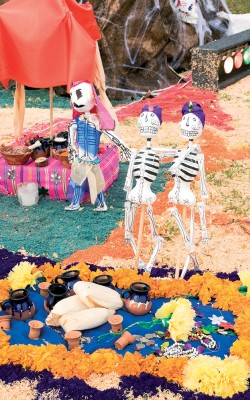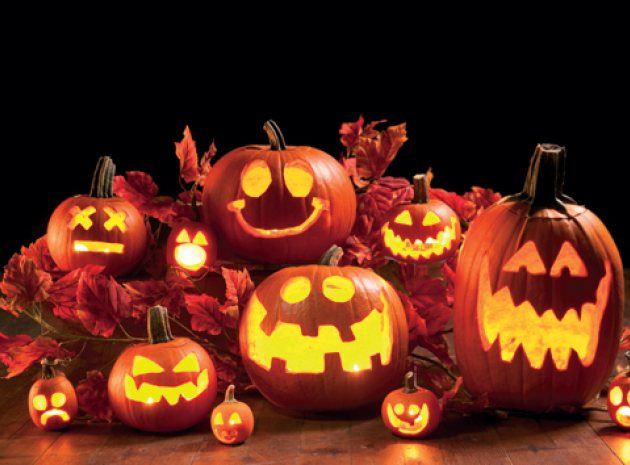Today you will…
• Explore the differences and similarities in traditions and beliefs across a range of cultures
• Develop strategies for engaging with authentic texts resources
Offering insights into other cultures is one of the unique ways in which languages can contribute to the curriculum as it not only opens up the outside world to students but also gives them the chance to reflect on their own culture and values. Almost any context can be given a ‘cultural’ twist, but looking at traditions or holidays such as Hallowe’en can be particularly fruitful. This is not only a theme that students can relate to (anything ghoulish and grim always seems to go down well) but is also one that can be linked to many festivals around the world that share some common elements, such as La Toussaint in France, Día de los Muertos in Mexico and other Central and South American countries, Walpurgisnacht in Northern Germany and Nordic countries, and Qing Ming and/or the Hungry Ghosts festivals in China. It also gives pupils an opportunity to experience a range of authentic web based resources such as text and video.
Starter activity
Show students a series of images relating to summer and winter seasons, such as weather, activities, clothing etc. Get them to talk to each other about the pictures. Depending on the level of the class it could be the simple equivalent of “It’s cold” or “They are wearing coats” to “I think it’s cold because…..” or “When it’s warm I…...”. Challenge pupils to come up with a title in the target language for the images as a whole (e.g. ‘Seasons, summer and winter’). If the vocabulary for seasons is not familiar then this is the opportunity to introduce it.
Main activities
1. Introducing Hallowe’en
Explain to the class that there are some festivals that mark the transition from summer to winter and vice versa and that these in turn are often linked to other religious festivals or beliefs across many cultures. Show them some images relating to Hallowe’en; it could be a ‘slow reveal’ PowerPoint where a bit more is shown as pupils respond to some simple questions. Explain that Hallowe’en is one such festival, and get learners to tell each other as much as they can about it in the target language using the vocabulary they already know. This might just be saying the date, or short phrases such as “You can see a black cat”; or coming up with sentences in which they say what they do or wear.

2. Decoding text
Give the class a text to read in the target language about Hallowe’en – its origins, history and traditions. The complexity will depend on the ability and level of the class, and students should be told that there may be words they don’t recognise, but that they should try to work out as much as possible before using dictionaries. The text could be presented on a series of cards to make it more accessible and less daunting. It could also be divided into chunks with pupils split into different groups working on a particular section; they then form new groups, one pupil from each of the subgroups, and report back to each other what they have found out.
3. Sharing strategies
Once the class has established some of the key facts about Halloweens, get them to share what strategies they used to decode the text in a mini-plenary; these are likely to include working out the meaning from the context and the use of cognates. Then tell them that they are going to use the same strategies to familiarise themselves with some more key Halloween vocabulary such as bat, vampire, ghost, pumpkin, devil, dead, candle, to dress up etc. This vocabulary can be presented in the form of a domino game with pupils matching a picture of word to a definition of that word in the target language. Give students the opportunity to use the vocabulary in conversations about the festival.
4. Comparing traditions
Remind students of the date of Hallowe’en and establish with them what the meaning of the word is. Tell them that although Hallowe’en may exist in the target language countries, it is not necessarily the main festival at that time of the year. Introduce this idea to the students with some images e.g. La Toussaint – people visiting cemeteries and taking chrysanthemums to lay on graves in cemeteries; Día de los Muertos – decorating graves with marigolds, taking presents and sweets, lighting candles, symbols such as skeletons and skulls made of sugar and sweets; Newweling – traditional coiled candles from Mainz, lit on November 2nd; Walpurgisnacht – celebrated six months after Hallowe’en to mark the end of the darker part of the year by lighting bonfires, burning witches, wearing masks; Qing Ming – visiting the cemetery and sweeping the graves; Hungry Ghost – offering food and gifts for the dead, burning paper money and incense etc. Encourage pupils to use some of the vocabulary they have encountered already in the lesson to describe what they can see. In this way they can begin to identify some links between Hallowe’en and other festivals.
Get learners to do some internet-based research on one or more of these other festivals, discovering key fact and comparisons with Hallowe’en. They could either look at one that relates specifically to the language they are learning or – and this would really allow them to make some cross cultural links – divide them into groups, each one looking at a different festival (this activity has the potential to extend beyond one lesson period).
Home learning
• Pupils could do further research and then produce a presentation, a poster, an audio recording or a role play, such as a question and answer type interview, of their findings.
Summary
Once students have had a chance to find out some information this could be pooled together in the form of a Venn diagram, which shows what elements the different traditions have in common and which are unique. The lesson then could be rounded off with a quiz or a fun song such as “Süßes oder Saures” (Trick or treat) tiny.cc/t2yalw; “C’est l’hallowe’en” http://tiny.cc/ a8yalw; or “Los esqueletos” “http://tiny.cc/3jzalw”.
Info Bar
Stretch them further
You might like to point out how Hallowe’en is spreading to countries like France, where traditionally it has not been celebrated, because of the influence of commercial considerations. You could, for example show students the image of 8,000 pumpkins near the Eiffel Tower which were used to advertise France Telecom’s services – http://tiny.cc/7xh9kw or http://tiny.cc/57h9kw , or a short video clip in which people are interviewed about how much they know about Hallowe’en and children are shown dressing up: http://tiny.cc/i828kw. for students of German there is a series of short videos http://de.wiki-videos.com, each lasting 45 seconds, on a huge range of topics which could be shown.
About the expert
Liz Fotheringham is an experienced MFL teacher, former regional subject adviser for the secondary curriculum and trainer with the Network for languages.









